May 2, 2011 |
BITE: My Journal
Tickets: The Adria Brothers Channel Groucho
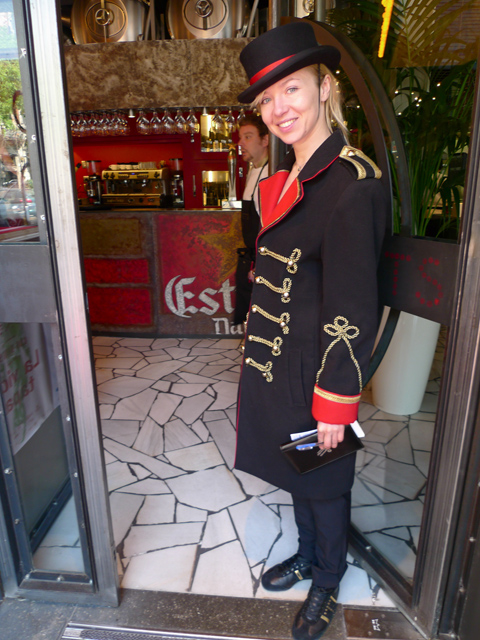
Your name on the list? That’s brother Albert behind the ringmaster. Photo: Steven Richter At times Ferran Adria seems tortured by the “bestial pace” of El Bulli demands in Rosas. The thousands on waiting lists. The need to come up with new extrusions and inhalations to utilize the technical inventions of his crew. The strain of financial losses. Still, the gob-smacked food world reeled when he said he would close forever. I almost expected a relocation of the angst at the Ferran brothers' new tapas shop in Barcelona. And yes, it’s already who-do-you-know to get in – but if you can just relax, you’ll see that Tickets is about Boys Just Wanting to Have Fun.
It’s a child’s dream. Saturday matinee double bill at the movies. The Circus. The Good Humor Man. A Basques adolescent’s dream. Can it possibly be booked three months ahead? At the admittedly unfashionably early (this is Spain, after all) lunch time of 2PM, looking in through a window devoted to flutters of paper on which friends have described what a tapa is, all I see is the hired help loitering. The door is locked.
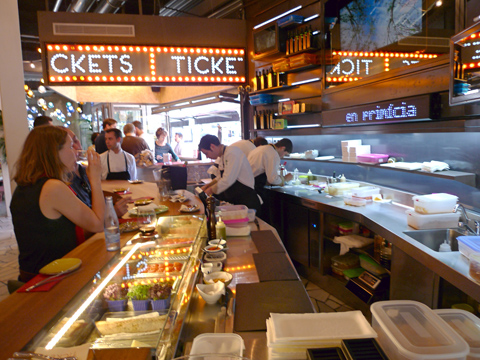
The show is just warming up at 2 on Sunday at Tickets. Photo: Steven Richter Then a smiling blond ringmaster in a flat top felt hat scans her list - and we’re in. Well, not quite. We are herded into a small holding pen where we are supposed to brush up against favored others drinking cava, “like in a Groucho Marx movie.” Our Barcelona pal doesn’t see the step up and staggers to avoid a fall. Yes. No. Cava? Before even a leer or a mustache twirl we’re being led to a table, our heads swiveling, bombarded by icons, hams and toys. Is it fast food America? Is it Disneyland? An adorable toddler staggers by us, squealing with joy to lick the glass display case of the pastry station.
There are cars and trucks and helicopters made out of tin cans hanging high at the sweets post, hams and tomatoes framing the charcuterie, the staccato lights of a theater marquee announcing Tickets. Shouldn’t we sit at a counter to watch master chefs injecting, shaving and otherwise resuscitating whatever we’re going to eat?
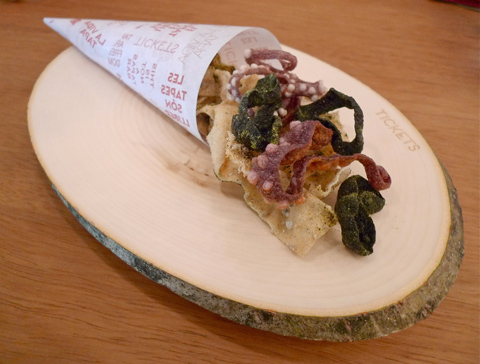
Fried crisps, small fish and skin with seaweed powder. Photo: Steven Richter Maybe we’re fine at this bare table, where the waiter with his mastery of English and the quirks of this menu (in Spanish, Catalan, Basque and English) is quickly becoming our best friend. The listings unfold like a fan on both sides in many categories, with Moet & Chandon listed below Coca Cola among the house patrons. Yes, “Patrocinen,” it says.
“Should I order the empanada? Do you like sardines?” I ask our local pal. “Try it,” says the waiter, thumbing away on a computer pad. “If you don’t like it, you can send it back.” Something is excessively fishy between those thin leaves of pastry. Back it goes. Somewhere.
I order pescaito frito with Galician seaweed powder from the snacks column to nibble while we study the options and decide what to order. It arrives on a plank of wood, salty squiggles and chips of fish skin, spilling out of a paper cone, evoking fish and chips, but not close enough. A trio of forceps appear. Can that be related to the mini air bags stuffed with Manchego cheese froth and Iberian bacon grease?
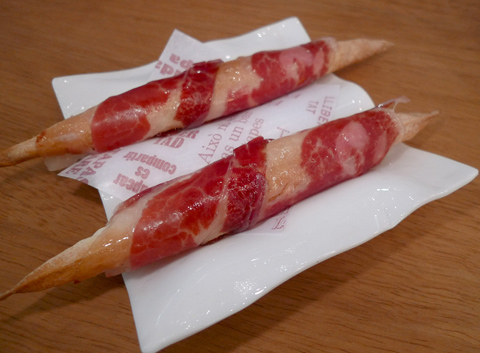
Would I rather have a ham sandwich or an “air baguette?” Photo: Steven Richter Well, in fact, the food is jokey but it can be good, like the pointy air “baguettes” wrapped with splendid Joselitos Iberian ham. Tomato tartare with the classic beef flavorings, a quail egg, watermelon chunks and broken bread crisps is a stunning intensity of tomato. Forget the green apple bread, a Styrofoam crunch alongside perfectly good tuna belly with a squirt of juice from the Basque pepper pipparo and a sprinkling of salmon roe.
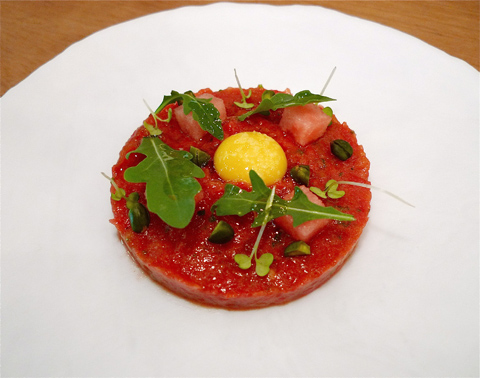
Tomato “tartare” with a quail egg and intensified tomato savor. Photo: Steven Richter Order liquid ravioli and you know that it will arrive as a jelly blob on a white china spoon to pop in your mouth for an explosion of payoyo cheese. Tapitas of the earth include asparagus with black truffle vinaigrette, minted peas, roasted red peppers with jellied hot pepper sauce, and something as familiar and reassuring as orange salad with olives, cumin, mint, orange zest and a peppery after-kick.

What does every little Basque kid want? Her own ice cream cart. Photo: Steven Richter The pork rib juiced-up sauce with patatas confit’d in olive oil and Iberian boiled ham is too good to leave behind. “Do you have bread so we can sop up this sauce?” my friend asks our waiter. He nods and brings bread, good bread, real bread. Bread baked in an oven. It feels naughty to be eating it – in the church of air bread.
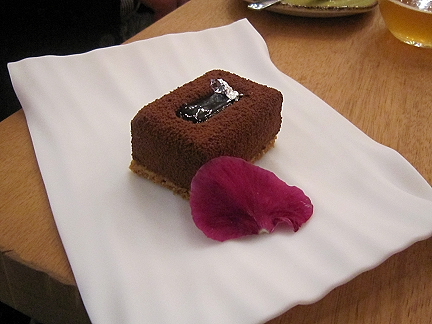
Desserts by brother Albert and his team are serious pleasure.
Now we have been noticed. Ferran’s brother Albert, the pastry wizard, stops by. “Mark Bittman is coming,” he says. “Do you know him?” Now I see why the tables are spaced far apart. A server must be able to maneuver the ice cream cart between them. The multitudes on wait lists would be shocked to see how few people are eating here today. How friends and family monopolize the tables: Mark Bittman eating lunch with Ferran’s wife, Isabel.
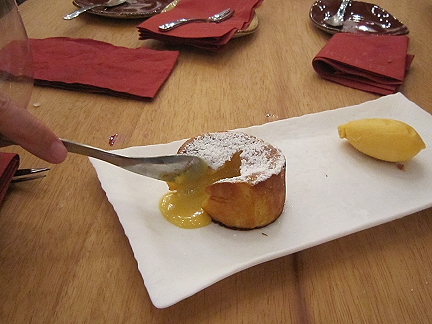
Almond cake oozing caramel beside intense apricot ice cream.
The little girl in love with sweets has brought a little boy to have a lick at that pastry window. He’s too young to get it. Happily we are not. The desserts are sensational, not to be missed, and in our case, a gift from the house. No joke here. Chocolate cake with silver leaf and a pansy petal. Molten almond cake running across the plate paired with marvelous apricot ice cream. The bill comes stuck into a Pallerro cured ham tin. Less than $45 per person. Service not included. Seems like the waiter forgot to charge for three beers. I never did make that perilous cliffside trek to Rosas for El Bulli and I probably would not return to Tickets. But I wouldn’t have missed the adventure of being here. To read an earlier Postcard from Barcelona, click here.
Avinguda Parallel 164, Barcelona. To book: www.ticketsbar.es
***
Cordeillan-Bages: At Play in the Fields
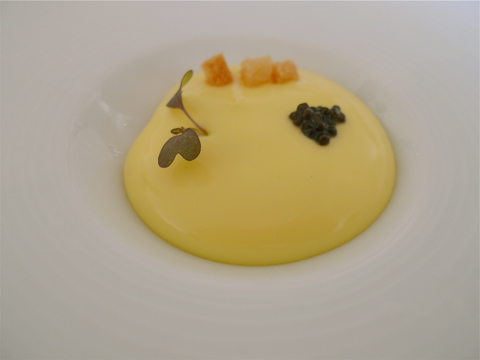
Jean-Luc Rocha's simple egg amuse launches a simple lunch with fireworks. Photo: Steven Richter It’s a shallow hill of bright yellow egg yolk, elevated to a heightened egginess, with a small sprig of green and a dab of local caviar - this amuse from the two-Michelin-starred kitchen of Jean Luc Rocha. I take a small bite and feel the taste buds hit the top of my head, one of those “I can’t believe what I’ve just put in my mouth” moments. I wonder if I should just inject it directly into my heart.
These are days of indulgence. The Road Food Warrior and I, disembarked from nine days aboard Seabourn’s round the world cruise ship, Sojurn, have just come from the sybaritic three-star embrace of Michel Guérard at Eugenie les Bains.
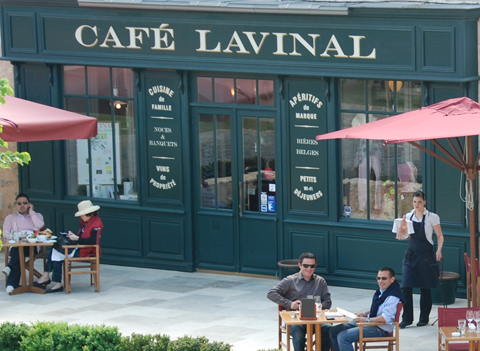
Jean-Michel Cazes imagined Lynch-Bages village restored and here is it's cafe. Photo: Steven Richter Now I’m installed in this vanilla room just outside Pauillac, in the Bordeaux wine country. It might seem stern or understated, especially after the theater and sensuality of Christine Guerard’s newest Imperial Suites. But the creamy light is rich and warm in the dining room at Chateau Cordeillan-Bages. There is a crystal bowl and a black glass ball on the heavy raised striped damask cloth. “It represents yin and yang,” says our host, Charles Thuillier, assigned to educate, amuse and feed us, by the legendary Jean Michel Cazes of Lynch Bages, whose knees await surgery…whose lunch will be so pitifully meager it cannot be eaten in our presence.
A sturdy figure in a khaki Chinese jacket, with the lived-in face of a dedicated sybarite, he has never stopped adding to the legend of his inherited house, starting with the Wine School in 1989, a blanc de Lynch-Bages in l990, the vibrant restoration of the once abandoned Village of Bages, where locals run the bakery, wine shop, café-brasserie, a butcher shop and charcuterie, the houseware emporium, the classic Chapon Fin in Bordeaux, as well as the relais where we will lunch. Ariane Daguin has brought us together, so we are special guests, delivered to the relais in his golf cart.
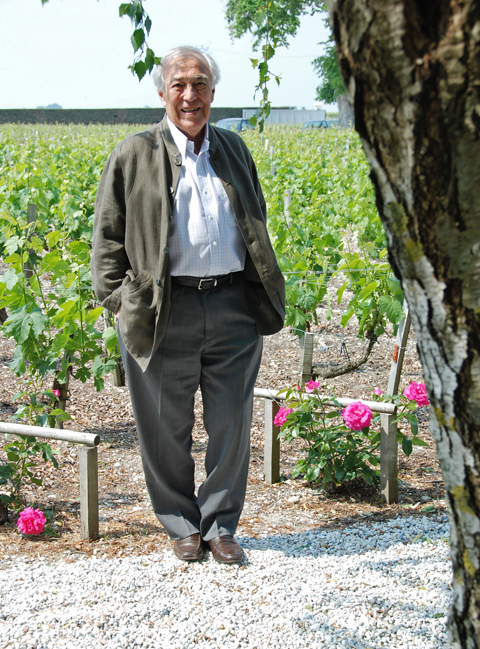
The Lord of all he surveys,Cazes plants roses around the grape vines. Photo: Steven Richter Unlike the many choices and chef’s tasting at dinner, lunch is simple in the 18th century house of Cordeillan, a 60 Euro ($90) three course prix fixe called “Impromptu,” a convenience for visitors to Pauillac, for tourists who come to do a class at the winery and for locals, even for other vintners wooing retailers. The staff, men and women in dark suits, move efficiently with trained purpose: one assigned only to the rolling bread cart, where he will slice spectacularly crusty loaves from the village bakery to order - white, whole grain, seaweed. I am not tempted by big brightly colored lumps of salted paprika or seaweed butter, but I must try something wildly creamy described as “near butter.”
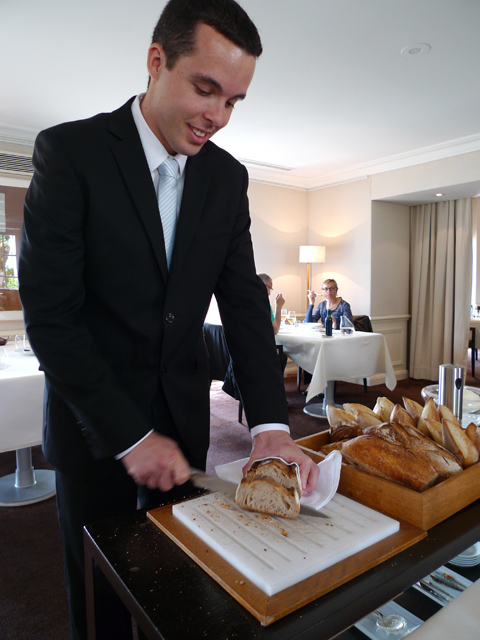
Crusty bread sliced to order and a near-butter revelation. Photo: Steven Richter I love good bread so much, I rarely use butter. But now I can’t stop eating this satiny burrata-like whip. I’m out of control. Only that bright yellow amuse finally distracts me. “Are these the yolks that are left after you use the whites to clarify the wine?” I ask our escort. Normally he leads eight or ten 8 Euro winery tours and tastings a day. Not many tours mushroom into lunch.
I can only hope that our habitual ascetic salads at home have left Steven and me grace for today’s excess. He has egg again as his first course, poached in a creamy emulsion of Comté with crackling bits of Jabugo ham. Warmed ham and onion-studded brioche arrives with my foie gras, two thin slices cooked in their own fat with traces of duck flesh running through them and a ribbon of duck ham wrapped around the edge. A tassel of crunch: radish, fennel, frisee, impeccably acidulated to cut the richness, sits alongside.
Sadly, my request that the maigre - a not exactly thrilling local fish - be “undercooked,” has been ignored. Shall I be a good sport? After another bite, I send it back.
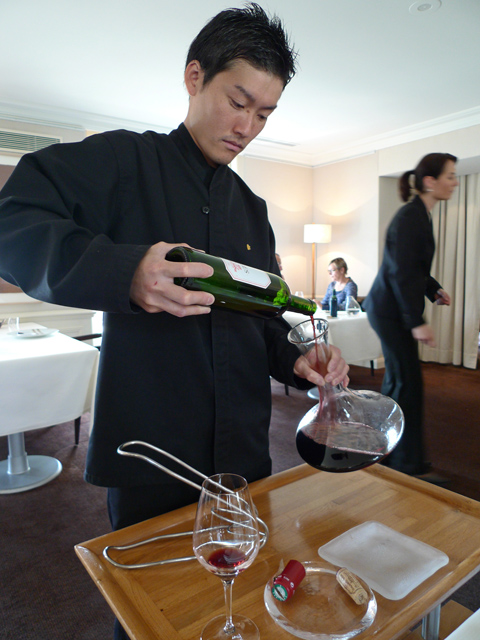
The sommelier decants a big, brawny 2001 Lynch-Bages. Photo: Steven Richter The sommelier decants the red. It’s a 2001, not a great year for Bordeaux, but Thuillier thinks it reflects the terroir. Waiting to see how it will develop in the glass, I remember lunches from the 60s and 70s, when we could still afford Bordeaux.
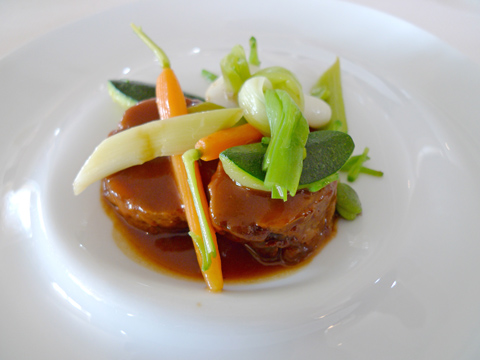
The chef's discipline shows in chunks of veal shank with spring vegetables. Photo: Steven Richter
I had ordered cheese before I discover that even these few courses would be more than enough – the near butter and egg amuse are the culprits. But still, with the last of the Lynch-Bages in my glass, and not many hours left in France, I finish the rectangle of Morbier, the two year-old Comté, and most of a ripe creamy chunk of chevre du Gers. I don’t mind the fuss of a rusty espelette pepper stripe along one side studded with pistachios and pine nuts. And another of herb green. I’d rather have chefs play with painterly style than molecular fakery.
At this point dessert needs to be a tart sorbet. A scoop of raspberry and another of pear wearing a giant silver hoop of pulled sugar arrives on a chilled plate of thick double glass. The bread cart returns with sweets: chocolates, nougat and the region’s famous canalé – dark and crisply caramelized on the outside, soft custard within. In the slow-moving traffic going home, we decide to cancel dinner.
Route des Châteaux
33250 Pauillac (Gironde):
33 (0) 5 56 59 24 24
Fax 33 (0)5 56 59 01 89
Château Lynch Bages for tours and tastings: 33 (0) 5 56 73 19 31
L’Ecole du Bordeaux wine school: 33 (0)5 56 90 91 92